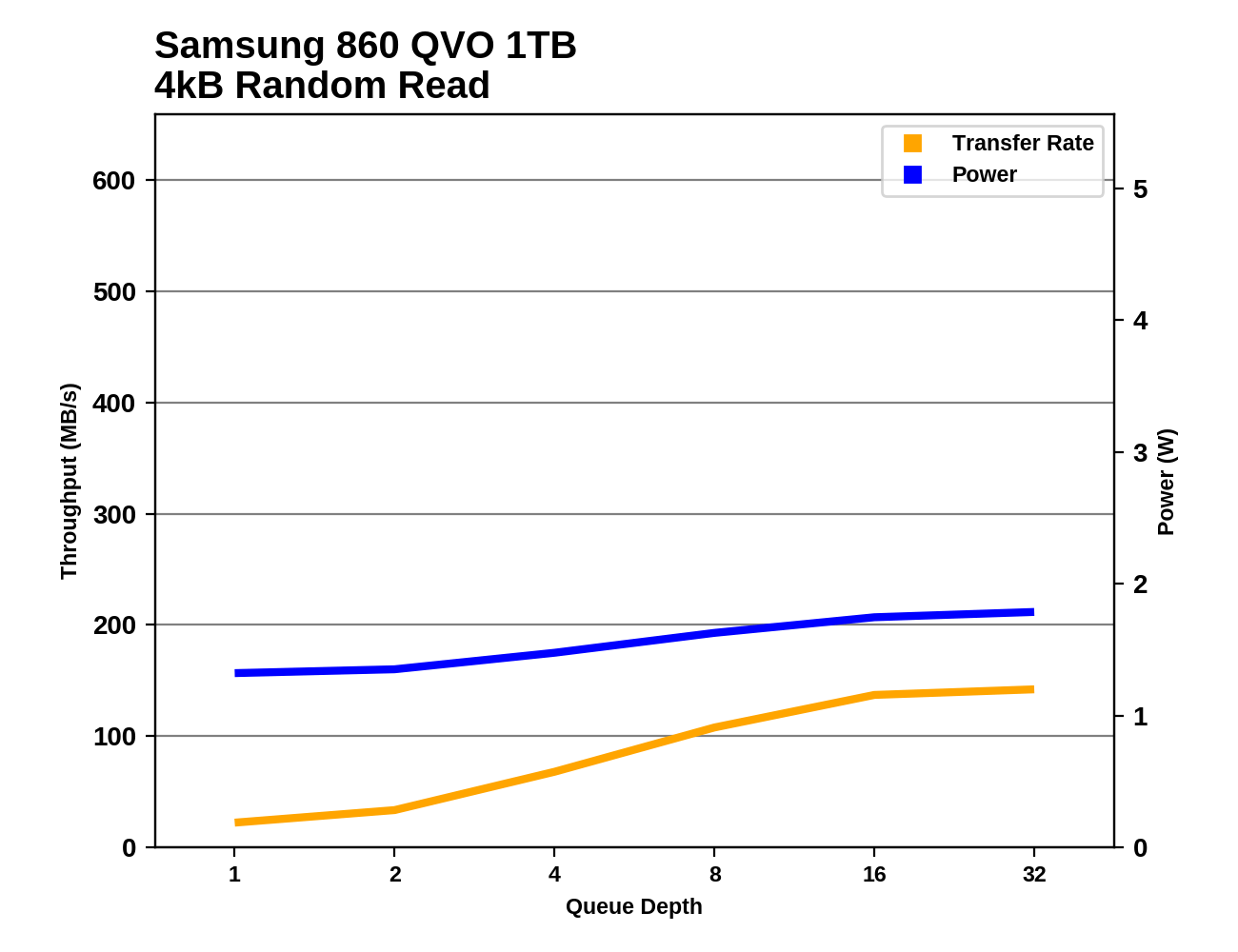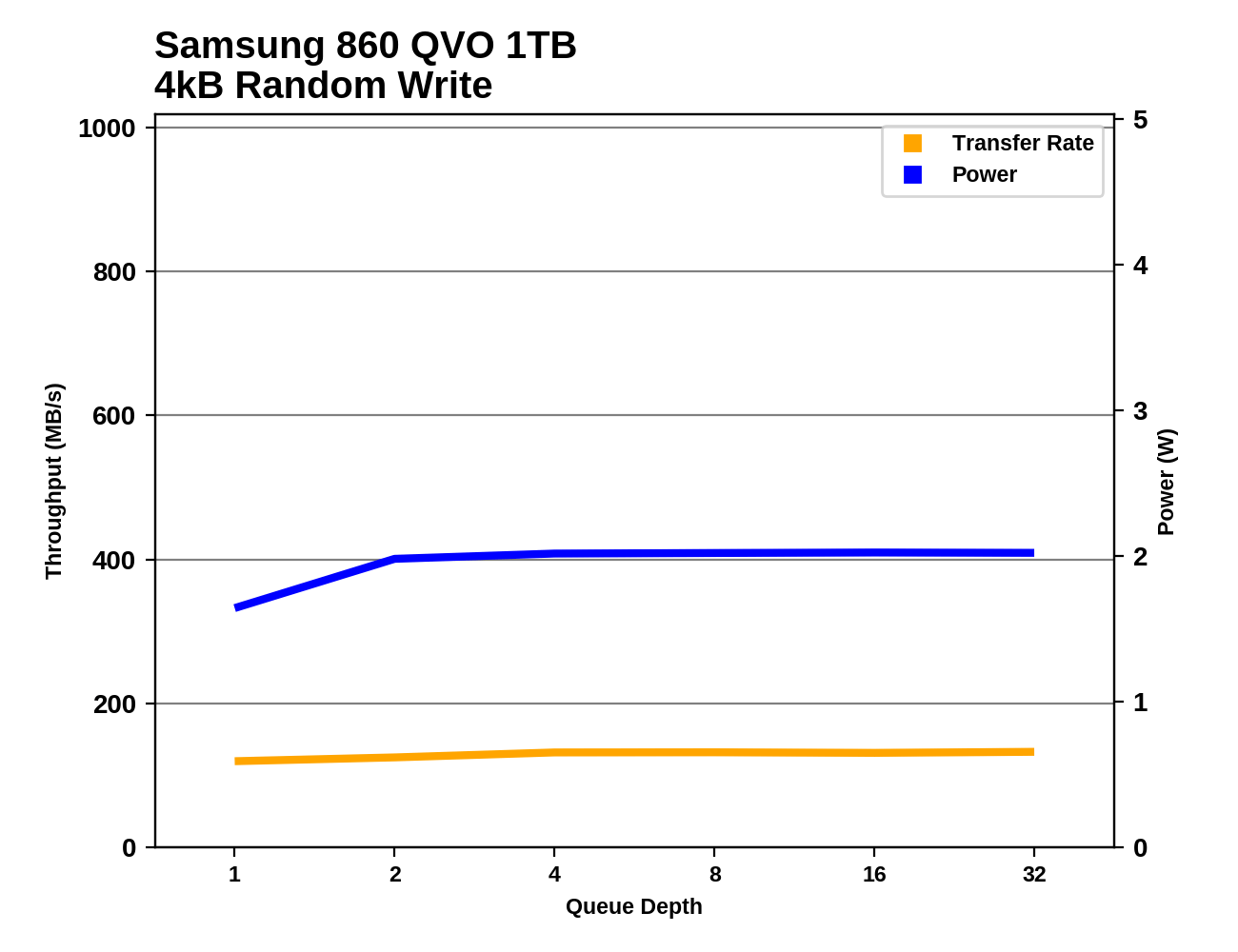The Samsung 860 QVO (1TB, 4TB) SSD Review: First Consumer SATA QLC
by Billy Tallis on November 27, 2018 11:20 AM ESTRandom Read Performance
Our first test of random read performance uses very short bursts of operations issued one at a time with no queuing. The drives are given enough idle time between bursts to yield an overall duty cycle of 20%, so thermal throttling is impossible. Each burst consists of a total of 32MB of 4kB random reads, from a 16GB span of the disk. The total data read is 1GB.

The burst random read performance of the Samsung 860 QVO is clearly lower than the 3D TLC competition, while the Intel/Micron QLC NVMe drives have no trouble competing against the field of mainstream SATA TLC drives. Even in the worst case of the smallest QVO being entirely full, read speeds are still vastly better than a hard drive.
Our sustained random read performance is similar to the random read test from our 2015 test suite: queue depths from 1 to 32 are tested, and the average performance and power efficiency across QD1, QD2 and QD4 are reported as the primary scores. Each queue depth is tested for one minute or 32GB of data transferred, whichever is shorter. After each queue depth is tested, the drive is given up to one minute to cool off so that the higher queue depths are unlikely to be affected by accumulated heat build-up. The individual read operations are again 4kB, and cover a 64GB span of the drive.

On the longer random read test, the Toshiba TR200 DRAMless TLC drive is no longer able to stay ahead of the 860 QVO, and even the Intel/Micron QLC drives fall behind most mainstream SATA drives (especially when full).
 |
|||||||||
| Power Efficiency in MB/s/W | Average Power in W | ||||||||
The power consumption of the 860 QVO during the random read test is only slightly higher than its TLC-based relatives, but that's plenty to push its efficiency scores into last place, given the poor performance.
 |
|||||||||
The queue depth scaling of the 860 QVO during random reads is fairly typical in shape, with improvements starting to taper off after QD16. However, the vertical scale is important: the QVO doesn't ever reach even half the performance of the best TLC-based SATA SSDs.
Looking at the 1TB 860 QVO's random read results compared to all the other SATA drives in the benchmark database, it is clear that the QVO isn't anywhere near the cutting edge for power efficiency or peak performance, but there are worse drives out there.
Random Write Performance
Our test of random write burst performance is structured similarly to the random read burst test, but each burst is only 4MB and the total test length is 128MB. The 4kB random write operations are distributed over a 16GB span of the drive, and the operations are issued one at a time with no queuing.

The SLC cache of the 860 QVO is very effective for the burst random write test, leaving it tied or slightly ahead of the 860 EVO.
As with the sustained random read test, our sustained 4kB random write test runs for up to one minute or 32GB per queue depth, covering a 64GB span of the drive and giving the drive up to 1 minute of idle time between queue depths to allow for write caches to be flushed and for the drive to cool down.

On the longer random write test, the larger SLC cache and greater parallelism of the 4TB 860 QVO helps it keep pace with other top SATA SSDs, but the 1TB QVO has to settle for being slightly faster than the DRAMless TLC drive.
 |
|||||||||
| Power Efficiency in MB/s/W | Average Power in W | ||||||||
The QVO is again a bit more power hungry than most of the TLC drives, which doesn't hurt the 4TB QVO's efficiency score much thanks to its good performance, but the 1TB QVO ends up tied for last place with the full-drive performance from the Intel/Micron QLC drives.
 |
|||||||||
The 1TB 860 QVO shows very little random write performance scaling with increasing queue depth, though power consumption does go up significantly from QD1 to QD2. The 4TB 860 QVO shows a much more typical scaling up to saturation at QD4, with a performance curve that is almost an exact match for the 4TB 860 EVO.
There are some TLC SATA SSDs that draw the same power to deliver half the random write performance of the 1TB 860 QVO, but in the grand scheme of things the 1TB QVO's results on this test are sub-par. The 4TB starts out in the same spot but ends up hitting the SATA performance wall without consuming too much power.












109 Comments
View All Comments
0ldman79 - Saturday, December 15, 2018 - link
I found some answers to that question on the Bench.https://www.anandtech.com/bench/product/2339?vs=22...
Load time, file copy times, etc, I guess more day to day testing would be appreciated. The spinner does a decent job on the BAPCo tests.
I'm wondering if the QLC will really improve my load times vs my 2TB mechanical drive that sustains nearly 200MBps read speeds in practice.
ewitte - Thursday, March 28, 2019 - link
Who in their right mind would purchase a QVO drive when the EVO is similarly priced? These drives perform poorly and have horrible longevity. 160MB/s writes after the cache!!!! I will not even touch the smaller EVO drives because the write speed is so low (500GB is ok but 1TB is so affordable now it is my minimum).Sanmayce - Friday, March 29, 2019 - link
Anand, please consider debunking the myth of data retention being limited to a few months.Really, where this myth originates from, f.e. if one buys QVO for backups what is the safe-time-between-losing-data?
My proposal is to fill the drive with 900GB 7z archive and test the integrity after, say, 6 months.
I myself am planning to buy the 1TB QVO just to find how durable it is under superheavy REAL-WORLD random read/writes - QD1. By the way, you are using 16GB spans in your tests, but the SLC is bigger than that, don't you see a problem?
bobhumplick - Thursday, May 16, 2019 - link
so if the intel 660p and the smasung qvo are the same price which one do you get?praveenvj - Friday, July 26, 2019 - link
Now that price has dropped to $400 for 4TB, does this make sense compared to EVO for daily driver PC?southleft - Monday, August 19, 2019 - link
Here we are about 9 months later - August 2019 - and the price of Intel's 660p 1TB model has dropped by 50% when it's on sale. So, for $85 - $95 you can get an NVMe drive with, say, 750GB of usable capacity and it will blow all of these SATA SSDs out of the water. In other words, if you don't fill the drive over about 75% full you'll have a smokin' fast rig.problemchild - Wednesday, October 23, 2019 - link
As a professional many comments here disregard what these drives are intended for and for obvius reasons you wouldn't want to buy them for a server array or high availability applications. Samsung has entered a product which is now competing with lower priced product \ brands. For the average consumer looking for a Samsung branded drive to be used as a basic storage drive for documents, photos, music and game storage it makes a lot of sense. Admittedly IMHO buying a 2TB SSD for general storage use at the $200 mark is extreme in comparison to $80 for a spinner but for some users but for gamers it may be worth the price to use as game storage drive.Scour - Sunday, June 28, 2020 - link
Question: If the SLC-cache is full, the speed drops, that´s clear. But what happened if the SSD have a power loss directly after the data-writing ends? Is all Data still accessable on the SSD (because data still have to be copied from the SLC-cache to the QLC)?leexgx - Thursday, August 6, 2020 - link
did they ever issue a firmware update with the 4TB QVO, EVO and Pro samsung ssds been problematic sometimes not working